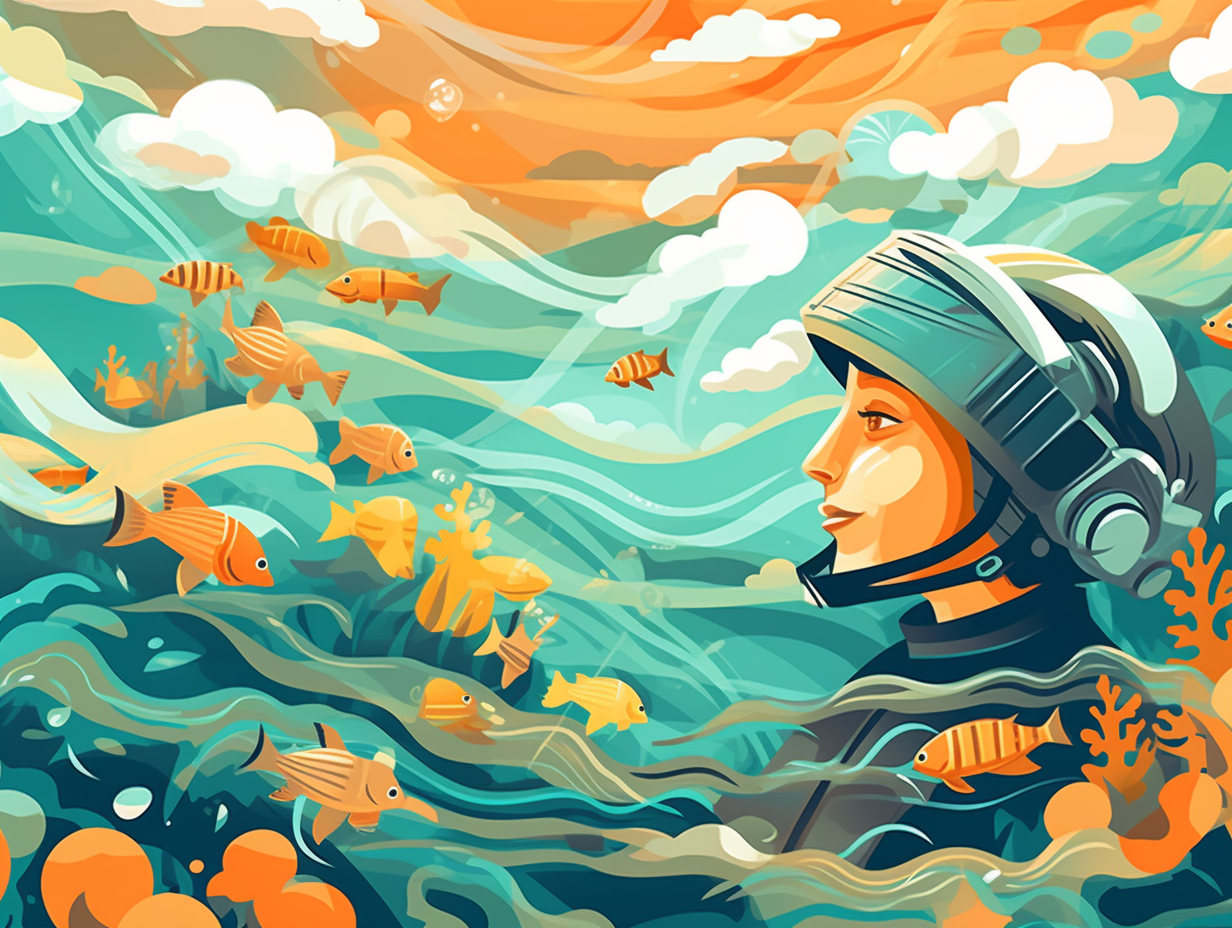15 Amazing Fun Facts About Ocean Currents: Uncover the Wonders Beneath the Waves!

1. Ocean's Conveyor Belt Sushi
Move over, world-famous conveyor belts of sushi restaurants: the ocean has its own conveyor belt, and it's not just serving up seafood! The ocean conveyor belt, or thermohaline circulation, moves water around the globe through vertical and horizontal movements, driven by differences in temperature and saline levels and redistributing heat and nutrients in the process.
Source => nationalgeographic.org
2. Climate Factory Worker
Did you know that our oceans have their very own conveyor belt, transporting heat like a diligent climate-controlled factory worker? Check your weather app, because it may be saying, "You're welcome!": The system of ocean currents, both surface and deep-water, helps regulate our planet's temperature and weather patterns by moving heat from the tropics to the poles. However, the all-important sinking effect is being undermined by warmer, less dense water, causing a slowdown that could lead to higher sea levels, floods, and extreme weather – all thanks to our reluctance to rein in those pesky greenhouse gas emissions.
Source => sofarocean.com

Did you know the tides are a cosmic dance between the moon and the sun, creating an oceanic rollercoaster at the beach? Discover the secrets behind spring and neap tides! 🌙☀️🌊
=> Fun Facts about Tides
3. Gulf Stream Fast & Furious
Who needs all the rivers when you've got the Gulf Stream? This feisty current zips along the Atlantic like the Fast & the Furious on water, showing off its horsepower: The Gulf Stream has an average speed of 6.4 kilometers per hour (four miles per hour), with a whopping 1.6 kilometers per hour (one mile per hour) when it widens towards the north, and transports more water than all of the world's rivers combined.
Source => oceanservice.noaa.gov
4. Seas' Golden Stinky Carpets
Plot twist in the world of oceanic voyages: forget buried treasures and pirates, the seas have their own golden, stinky carpets! The Sargassum seaweed, making a red-carpet appearance from Africa's western coast to the Gulf of Mexico, give marine critters a home but excessive blooms wash ashore, causing a ruckus on beaches with its stench.
Source => nytimes.com

5. Atlantic's Natural Thermostat
If the Atlantic Ocean ever needed a central heating system, it's all thanks to the Gulf Stream's hotshot: a warm-water current responsible not only for the cozy winters on the northeastern coast of the United States but also for keeping western Europe toasty even when it has every reason not to be. Consider the Gulf Stream a massive, benevolent serpent with the strength of seventy Amazon Rivers, keeping the climate temperate with a little help from atmospheric tango partners. Quick fact attack: this natural oceanic thermostat gives the resulting heat to higher latitudes, driven by the intricate dance between the ocean and the atmosphere.
Source => oceanexplorer.noaa.gov
6. Ocean Currents: Prom King & Queen
If the ocean had a high school yearbook, ocean currents would win "Most Influential Student" while looking effortlessly cool in their leather jacket: These powerful flows are shaped by a medley of factors such as wind, tides, Earth's rotation, solar energy, and water density differences, and they play a phenomenal role in heat redistribution across the globe, influencing weather patterns, climate regulation, and nourishing marine ecosystems by cycling crucial nutrients and gases.
Source => nationalgeographic.org
7. Speedy Currents, Thriving Life
Speedy gonzalez has nothing on these waves: Ocean currents can travel over 100 miles per day, powered by wind patterns that are influenced by the Earth's rotation and the Coriolis effect, ensuring marine life thrives even in the most far-flung corners of our watery world.
Source => oceanservice.noaa.gov
8. El Niño: Tropical Party Pooper
Talk about a tropical vacation gone wrong: El Niño weakens Pacific trade winds and sends warm surface water on a journey from the western Pacific to South America's coast, disrupting the marine ecosystem and putting a damper on the fishing industry.
Source => nationalgeographic.org
9. Ocean's Garbage Patch Gala
Did you know the ocean has its own version of a "highway to the danger zone"? Welcome to the Great Pacific Garbage Patch's greatest hit: The currents in the North Pacific Subtropical Gyre are like a swirly conveyor belt that transports debris from all corners of the world, mingling debris from the Western Garbage Patch near Japan to the Eastern Garbage Patch situated between Hawai'i and California – truly an international affair.
Source => nationalgeographic.org

10. Tsunami Race Cars vs Current Snails
If tsunamis were race cars and ocean currents were garden snails, they'd still never beat each other on a drag strip: Despite tsunamis clocking in at whopping speeds of 500 mph (800 km/h), our ocean currents take the scenic route, with the speedy Gulf Stream only reaching top speeds of 5.6 mph (9 km/h) and the deep-diving Antarctic Circumpolar Current meandering at a leisurely 3.4 mph (5.5 km/h).
Source => weather.gov
11. Coolest Water Slide: California Current
Hold onto your surfboards, folks, it's time to learn about the world's coolest water slide - found right off the coast of North America: The California Current is one of five major coastal currents affiliated with strong upwelling zones, flowing southward from southern British Columbia to Baja California Sur, forming the eastern boundary of the giant swirling Pacific playground called the North Pacific Gyre.
Source => en.wikipedia.org
12. Spilling Drinks: Great Salinity Anomaly
When Mother Nature accidentally spilled her drink in the North Atlantic: The Great Salinity Anomaly of the late 1960s and early 1970s occurred when fresh water flooded the North Atlantic Ocean, creating a layer of lighter water on the surface that disrupted the thermohaline circulation system, ultimately sending northern Europe's climate into a frenzy.
Source => energyeducation.ca
13. Poseidon's Garden Fertilizer
If Poseidon had a garden, coastal upwelling would be his miracle grow fertilizer: Coastal upwelling regions make up just one percent of the ocean surface but contribute a staggering 50 percent of the world's fisheries landings, thanks to their nutrient-rich waters that fuel incredible productivity and make them vital ecosystems for marine life. The catch? Upwelling might also send baby sea creatures on unexpected journeys, affecting the replenishment of coastal populations.
Source => oceanexplorer.noaa.gov
14. Currents' Marine House Party Cleanup
Ocean currents have an interesting way of cleaning up after our marine house parties: they make festive garbage whirlpools! Alas: these swirling vortexes of ocean gyres accumulate copious amounts of marine debris, including plastic particles, causing havoc to marine life when the tiny plastic morsels crash their dinner parties and sneak into the food chain.
Source => nationalgeographic.org

15. Tide-Surfing on Poseidon's Coaster
If Poseidon had a coaster for his celestial mug of seawater, it would surely be surfing on the Qiantang River: The world's largest tidal bore prowls these waters in Hangzhou, China, boasting waves up to 9 meters (30 feet) high, traveling at speeds of 40 kilometers (25 miles) per hour, making it a mesmerizing - albeit risky - spectacle for tide-watchers, surfers, and kayakers alike.
Source => nationalgeographic.org
Related Fun Facts




















